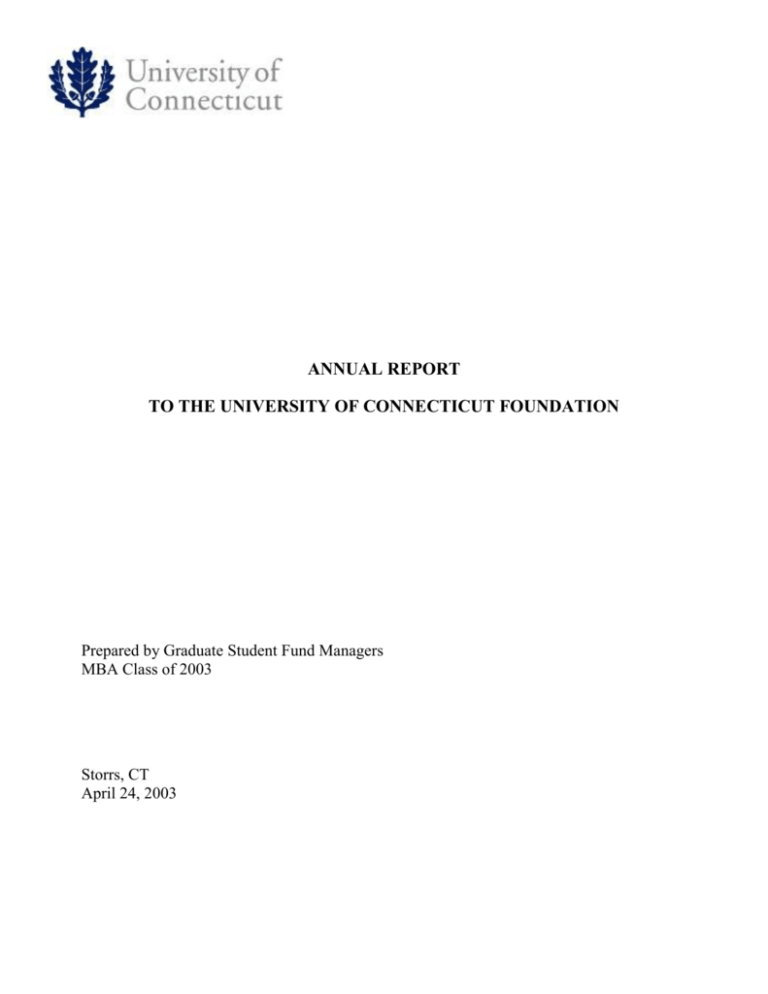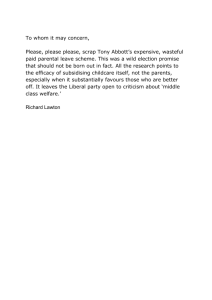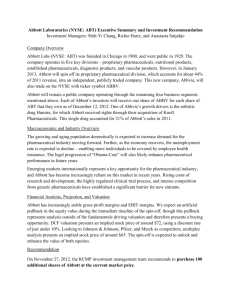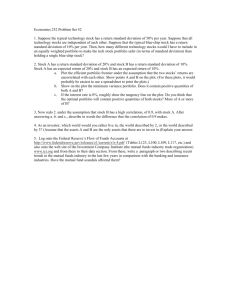annual report - University of Connecticut
advertisement

h ANNUAL REPORT TO THE UNIVERSITY OF CONNECTICUT FOUNDATION Prepared by Graduate Student Fund Managers MBA Class of 2003 Storrs, CT April 24, 2003 Executive Summary University of Connecticut Student Management Fund – MBA April 24, 2003 1. Investment Philosophy and Forward Expectations: Initially Uncertain outlook led to conservative approach Strong confidence in Health Care and Consumer Staples Low confidence with IT and Financials Now Bearish outlook due to war Remain confident in Consumer Staples Guarded optimism for economic turnaround 2. Portfolio Performance: Fund’s overall return since inception is 7.27%, including initial position in fixed income and cash. - Current Allocation (04/11/03) Sep. 30, 2002 Apr. 11, 2003 Return S&P 500 $815.28 $868.30 6.50% MBA Portfolio $199,675.86 $214,194.48 7.27% 64.41% in S&P 500 Index Fund — 28.22% in Equity — 7.37% in Cash Reasons for high concentration in the S&P 500 Index Fund: Inability to find individual stocks satisfying our strict buying criteria due to high volatility and continuously changing market, economic, and political situation Adoption of a conservative approach at the beginning Could not fully utilize the funds in the short term after converting them to S&P Fund from Bonds - Sector Allocation SMF Sectors Allocation - 04/11/03 9 sectors – S&P 500 based Methodology: emphasis on non-cyclical sectors and stocks, and diversification. The biggest sectors represented in our allocation are: Consumer Staples, Financials, Health Care, and Industrials. 10.0% 10.0% 10.0% 15.0% 15.0% 10.0% 15.0% Consumer Discretionary Consumer Staples Energy Financials Health Care Industrials Information Technology Materials 15.0% - Equity Selection Methodology: Fundamental analysis based on news and recommendations from financial websites, models, and industry benchmarking. Our risk control philosophy is based on stop-loss and upside price review. We look for stocks that have: Solid financials Strong management Consistent earnings growth Attractive valuation relative to the index Higher Return/Risk relative to market We have invested in 18 stocks. Our current equity holdings (14 stocks) are: Johnson Outdoors, Spartan Motors, TJX Companies (Consumer Discretionary), Wrigley WM Jr. Co., Sysco, and Pepsi (Consumer Staples), Exxon (Energy), Pfizer, Wellpoint Health Networks, and Abbott Labs. (Healthcare), Int. Flavors & Fragrances and MacDermid (Materials), Diebold (IT), and MetLife (Financials). Four stocks, Armor Holdings and General Dynamics (Aerospace), Group 1 Automotive (Consumer Discretionary), and Cognizant (IT), have been sold due to stop-loss rigor. 3. Lessons Learned: Task Stock selection process Identify right stock that matches our value growth investing strategy Upside review and Sell discipline Lessons Learned Holistic approach with emphasis on company’s related risks Focus on fundamental analysis and on stocks with growth potential and low volatility Act in timely manner Investment Philosophy The investment philosophy of the Student Managed Fund (SMF) is based on the diversification principle. Our intent is to accommodate styles and strategies considered reasonable and prudent. The objective of portfolio managers is to achieve the best possible trade-off between risk and return. A topdown analysis of strategy starts with the broadest choices concerning the make up of the portfolio. For example, the capital allocation decision is the choice of the proportion of the overall portfolio to place in safe but low return money market securities versus risky but higher-return securities like stocks. The choice of the fraction of funds apportioned to risky investments is the first part of the investor's asset allocation decision, which describes the distribution of risky investments across broad asset classes - stocks, bonds, REIT's, foreign assets and so on. Finally, the security selection decision describes the choice of which particular securities to hold within each asset class. Most institutional investors follow a top-down approach. We started our investment with the top-down approach and spent considerable time at the onset to decide on the portfolio allocation. Several factors went into that decision such as market conditions, prevailing interest rates and expectations about the economy and the future interest rates. After deciding on the portfolio allocation, we decided on the sectors to invest in and the proportion to be allocated to each sector. This decision was based on the attractiveness of the sectors in light of prevailing market conditions. Within each sector, the stock selection decision was based on company fundamentals – sound business philosophy, strong management principles, profits, growth potential, and position in the industry vis-à-vis competitors. As mentioned earlier, asset allocation decisions are made at a high organizational level for institutional investors. The UConn foundation, which oversees the SMF, follows the same principles and would like the SMF portfolio managers to decide on selection of securities as the portfolio allocation decision has already been accounted for at the top organizational level. In light of these developments, we have sold our investments in Fixed Income and our decisions, now, are primarily based on sector allocation and stock selection within the sectors. Market Outlook It is hard to make investment decisions in uncertain market with high volatility influenced by still declining economy and unstable geopolitical situation. While the expected war outcome has influenced the market in both directions, the successful end of the campaign could overcome the bearish economic outlook for the most part. The smooth progress on battlefield has helped stock market recover a lot since March 20. Short-term expectations are for further rebounding of the stock market. But while market indexes have climbed since the end of the war, investors are still cautious and companies hold their spending waiting to see the post-war impact on economy. Economic indicators were also biased. The unemployment rate in March remained unchanged at 5.8%. However, this does not mean the job market has stopped the downward movement. According to the Labor Department, except for construction, almost every major industry saw a drop in payrolls in March. The stable unemployment rate reflected an increase in the number of Americans who said they were “discouraged over job prospects” and had stopped looking for work, which meant they were not counted as unemployed under the Labor Department’s rules. Consumer confidence lost another 2.3 point to 62.5 in March. The low confidence level was partly due to the uncertainty of the war. Because consumer spending accounts for over two thirds of American economy growth, a lingering weak consumer confidence will ultimately lead to a recession. At the same time, we saw some positive signs on the movement of the interest rate. Although the Federal Reserve decided to leave interest rates unchanged last month, bond yields, which are set by investor buying and selling each day in the vast credit markets, rose recently. The increasing bond yield sends out a signal that investors believe market is at, or at least close to, the bottom point now, which leaves room primarily for improvement in future. There are some controversial factors affecting the economy in the long run: the expected low, stable oil price, and the instable global political situation. To some extent, the effects of these factors will offset each other. Whether the economy will benefit from the end of the war will depend strongly on who is going to participate in rebuilding Iraq afterwards. Worsened relationships between Europe and US due to the war in Iraq might have some significant negative impact in future, if common interests not met in post-war Middle East. Looking forward, we see: Economy continuing to struggle although the U.S. gross domestic product growth has resumed, Timing of the business recovery remains uncertain, and The last strong sector, the housing sector, recently has started to slump. Additional troubling factors are: Capital spending is weak Industrial production is slipping Employment outlook is troubled All of this suggests a weak first quarter, with growth of, at most, 1.5-2%. We have probably seen the low point in the profit cycle, as cost cutting and greater efficiencies are helping to partially offset sluggish demand. A firming in demand, which should follow a gradual strengthening in the economy later this year, will be needed before earnings really start to increase strongly. Our Experience and Lessons Learned Our reflection We are grateful to be selected to form the group of nine MBA students to manage the Student Managed Fund (SMF). Exercising the tasks of an analyst and portfolio manager team allowed us to apply academic knowledge to realistic portfolio management scenarios. We have gained valuable experience in selecting, analyzing, and valuing stocks, and presenting portfolio performance to the SMF Investment Advisory Board and the UCONN Foundation. This hands-on experience has honed not only our financial knowledge but also helped some of us in deciding to specialize in the area of portfolio management. Our approach We valued more than 25 companies and closely followed an additional 20 but the sluggish economy caused us to take a guarded approach, resulting in only 18 purchases so far. We have 14 holdings at the present moment. Nevertheless, we continuously assessed new opportunities in various markets by performing a holistic approach. We expanded the company analysis to include industry level indicators, such as business model and long-term outlook. The increased concerns about a possible prolonged war in Iraq overshadow the expected recovery of the financial market and add another uncertainty to our investment approach, particularly regarding the equity holdings. We have undertaken some steps to minimize these effects by holding a big part of our portfolio in the S&P index fund. The market it is so volatile that we can’t afford to loose any rally that may come if good news arises from the front line especially that our performance is compared with the index. Lessons learned 1. Task: Stock Selection Process We the based the overall decision on a holistic approach by soliciting several online tools, such as Value Line, Moneycentral, Quicken, and Yahoo! Finance to identify the top stocks in each sector. Our emphasis was to identify the company’s related risks, intrinsic value calculated from different models, company’s long-term strategy and investments, management effectiveness, competitors’ positions, historical and projected growth rate, financial soundness of organization, etc. 2. Task: Identifying the right stock that matches our strategy of value and long-term growth investing The highly volatile market offered us a great challenge but we focused on fundamental analysis to select stocks with growth potential and low volatility. We concentrated our analysis on the following key factors: - Solid financials - Strong management - Significant company and/or industry specific risks - Earnings growth - Valuation relative to the index We evaluated the stocks with respect to the following valuation models : - Dividend Discount Model - Multistage Growth Model - P/E Model - SSG We performed a detailed analysis of intangible information to reveal possible risk factors. 3. Task: Upside review of position and capturing of gains We lost the opportunity to lock-in some gains. Johnson Outdoors (consumer discretionary sector) at some point in December over performed the S&P500 by 33.64%-points. Johnson Outdoors reached its upside review price of $11.80. The review should always take place in a timely manner. 4. Task: Sell discipline Our fundamental sell strategy is to limit the downside risk while allowing for a larger upside return. Initially we established risk control depending on company or industry, ranging from 15% to -20% at the discretion of the sector manager. But in the advent of war with Iraq, we decided to reduce the downside risk by establishing stop loss prices of -15% of purchase price for all stocks. The sell strategy allowed us to protect our portfolio from massive losses. But it should not be seen as a sole safeguard of the portfolio’s value in uncertain economic and political situation. We should have more closely followed every holding so that no sell occurs just because the stock fell below its stop-loss price. Final Words We are very thankful to the Foundation of the University of Connecticut for providing us with this outstanding experience. We have not only had the opportunity to utilize our classroom knowledge in real life financial decisions but also gained insight to the functioning of the financial professional world through our interaction with the Foundation members, Investment Advisory Board, and the guidance of Dr. Chinmoy Ghosh and Mr. Patrick Terrion. We congratulate the incoming fund managers for 2003/2004 and hope that they will be able to leverage on our experience. Performance Holdings as of 04/11/2003 Sectors Company Johnson Outdoors Inc. Spartan Motors Inc. TJX Companies Wrigley WM Jr Co. Sysco Corporation Consumer Discretionary Consumer Staples PepsiCo Inc. Energy Exxon Mobil Health Care Materials Pfizer Inc. WellPoint Health Abbott Laboratories International Flavors & Fragrances MacDermid Industrials IT Financials Vanguard 500 Index Fund Cash Total Diebold Inc. Metlife Inc. No. of Shares Date of Purchase Purchase Price Current Price Capital Gain/Loss % of Total Portfolio 400 11/20/02 9.43 9.27 (1.70%) 1.73% 350 02/19/03 10.41 8.20 (21.23%) 1.34% 250 04/01/03 17.20 18.91 9.94% 2.21% 100.4 10/22/02 53.16 57.16 7.52% 2.68% 100 150 145 151.4 02/25/03 04/01/03 11/20/02 10/22/02 27.87 40.20 34.93 31.77 26.66 40.27 34.33 31.51 (4.34%) 0.17% (1.72%) (0.82%) 1.25% 2.82% 2.32% 2.23% 70 11/13/02 76.65 76.80 0.20% 2.51% 100 02/25/03 34.16 39.12 14.52% 1.83% 150 11/20/02 32.99 200 75 150 04/08/03 01/29/03 03/04/03 20.62 38.25 25.58 31.61 20.27 36.10 27.62 (4.18%) (1.70%) (5.62%) 7.97% 2.21% 1.89% 1.26% 1.94% 10/22/02 82.24 80.51 (2.10%) 64.41% 1 1 VFINX 1,720.09 SWMXX 15,795.13 7.37% 100.00% Best Performers Stock Abbott Laboratories Wrigley WM Jr Co. TJX Companies Exxon Mobil Metlife Inc. WellPoint Health Date bought 02/25/03 10/22/03 04/01/03 11/20/02 03/04/03 11/13/02 Purchase price ($) 34.16 53.16 17.20 34.93 25.58 76.65 Price ($) Holding Period Return (%) As of 04/11/03 Stock S&P500 39.12 57.16 18.91 34.33 27.62 76.80 14.52 7.52 9.94 (1.72) 7.97 0.20 3.55 (2.46) 1.14 (5.02) 5.63 (1.61) Overperform (% points) 10.97 9.98 8.80 3.30 2.34 1.81 Worst Performers Stock 1 Armor Holdings General Dynamics 1 Group 1 Automotive Inc. 2 Spartan Motors Inc. Cognizant Technology 4 Date bought Purchase price ($) Price ($) 10/22/02 11/13/02 16.36 79.71 01/28/03 2/19/03 03/10/03 Holding Period Return (%) Stock S&P500 12.96 63.70 (20.78) (20.09) (0.32) 0.55 (20.46) (20.64) 24.85 10.41 21.20 8.20 (14.69) (21.23) (4.26) 2.74 (10.43) (23.97) 22.67 5 19.30 (14.87) 7.94 (22.81) 1 Sold on 01/23/2002. 2 Sold on 03/04/2003. 3 As of 04/11/03. 4 Sold on 04/10/2003. 5 On 04/02/03, Cognizant Technology had a 3 to 1 stock split. Comparison of S&P 500 and SMF Allocation Sectors Consumer Discretionary Consumer Staples Energy Financials Health Care Industrials* Information Technology Materials Telecommunication Services Utilities Underperform (% points) S&P 500 As of 4/11/03 13.40% 9.40% 6.00% 20.60% 15.30% 11.30% 14.40% 2.80% 4.00% 2.80% SMF Stocks Invested Decided As of 4/11/03 10.00% 15.00% 10.00% 15.00% 15.00% 15.00% 10.00% 10.00% 18.71% 23.90% 8.24% 6.86% 23.26% 4.48% 14.55% * Specific SMF allocation decision for Industrials: 10% Aerospace/Defense; 5% Other. Investment Difference (% points) 5.31 14.50 2.24 (13.74) 7.96 (11.30) (9.92) 11.75 Appendix ABBOTT LABS (NYSE: ABT) Industry: Pharmaceuticals & Biotechnology Sector: Healthcare Beta: 0.85, as of 12/06/2002 Large Cap: $ 67.8 Billion Current Price: $35.08 as of 02/21/2003 BUY 100 shares (limit buy) @ $34.50 = $3450 Stop loss order: $29 (-15%) Upside Review: $42 (+20%) 1. Recommendation Strong Growth Innovative with promising pipeline of drugs New acquisitions and strategic alliances Different valuation models confirm Abbott’s strong growth potential Five different criteria and analyst ratings suggest that the stock is in a buy zone 2. Business Summary Abbott Laboratories makes health-care products including drugs, diagnostic tests, intravenous solutions, laboratory and hospital instruments, prepared infant formulas, and nutritional products. Also makes agricultural and chemical products. Brand names include: Biaxin, Hytrin, Similac, Isomil, Murine, and Selsun Blue.In the second quarter of 2002, Abbott and Celera Diagnostics, a joint venture between the Applied Biosystems Group and the Celera Genomics Group of Applera Corporation, entered a long-term strategic alliance to develop, manufacture and market a broad range of in vitro molecular diagnostic products for disease detection, disease progression monitoring and therapy selection. 3. Financial Highlights Company Industry S&P 500 Abbott’s income in the 4th quarter of 2002 Growth Rates % 8.60 0.50 0.40 was 3,342% higher than the same period in Sales (Qtr vs year ago qtr) the previous year and its sales were 780% Income (Qtr vs year ago qtr) 80.20 2.40 17.40 higher than the industry average. The same EPS (Qtr vs year ago qtr) 79.80 2.20 20.80 pattern was noticed for EPS. However, Abbott’s five-year average of EPS and Sales (5-Year Avg.) 8.41 11.58 7.47 sales is slightly worse that the industry’s. EPS (5-Year Avg.) 0.80 6.93 (5.77) The five-year average dividend is 33% Dividends (5-Year Avg.) 11.58 8.66 (2.75) higher than that of the industry. This shows that the company has experienced high growth in the past year. S&P 500 looks much worse if compared to Abbott. Abbott is quite volatile but the same pattern is vivid for the competitors Eli Lilly & Company (LLY) and Astrazenca PLC (AZN). Since Jan. 2001 Abbott followed the movement of S&P500 but it has outperformed that index. 4. Models Is this a good company? Time Series Analysis: Abbott is a good company, because it has steady, stable and sustainable pattern of measures over the 10-year period. Both EPS and DPS have a rising trend with an average of 11 %. ROE has a steady trend with an average of 37%. Based on the tree valuation methods the company growth rate on average is 15%. Is this a stock a good value? How the current stock price compares with the fair value. The Abbott stock is at a good value. All four valuation models (no growth, multistage growth model – high growth at 15% after five years 5 % growth, and P/E model) confirm that Abbott has strong growth potential. The models indicate different opportunities of growth and a different value of the stock. According to those models, the value of the stock is much higher than the current price, which confirms that the stock has strong growth potential. In addition to the valuation models, other criteria were taken into consideration in concluding that the stock is a buy. Criteria Recommendation 5 year horizon based on quartiles analysis Buy Valuepro.net Buy SSG – proprietary software Buy Analysts Ratings Buy 5. SWOT Analysis Strengths Weakness Valuable brand name Innovative Strong growth Diversified product portfolio Clear distribution channels Abbott is not subject to significant concentration risks relating to customers, products or geographic locations, except that three wholesalers accounted for 22 percent, 19 percent and 15 percent of trade accounts receivable as of December 31, 2002, 2001 and 2000, respectively. Four Models suggest the stock is a buy zone Heavily regulated industry - the development, manufacture, sale, and distribution of products are subject to comprehensive government regulation. Rising costs and risks of new product development Costs associated with trying to comply with FDA mandated Quality Systems Regulations (QSR) Opportunities Threats Aging US population & increasing demand Prescription drug reform may lead to accelerated patent expiration, because are mostly sold on prescription or recommendation of physicians Homeland Security development of diagnostic test Strategic business and technology acquisitions new acquired businesses: Knoll Pharmaceuticals, Vysis, Inc, Biocompatibles International plc, BASF, Hokuriku Seiyaku Co., Vysis, Inc., (leading genomic disease management company) In October 2002, Abbott announced restructuring plans to align Abbott's global manufacturing operations with its scientific focus and to achieve greater operating efficiencies in its Diagnostics and International segments. Implementation has started in 2002 Pricing pressure from generic manufacturers, peers, HMO companies, & government agencies Strong competition: price and search cost for technological innovations Expiration of patent protection can affect the future revenues and operating income of Abbott.







